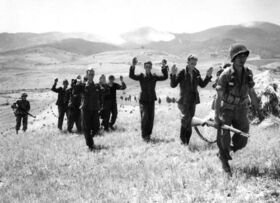Post Second Europan War Crisis of 1945
This article is incomplete because it is pending further input from participants, or it is a work-in-progress by one author. Please comment on this article's talk page to share your input, comments and questions. Note: To contribute to this article, you may need to seek help from the author(s) of this page. |
The Post Second Europan War Crisis of 1945 (5 August 1945 - 17 July 1948) were a series of conflicts that took place in Northern, Southern Asianna and East Zemuria following the Second Europan War. The series of conflicts and battles were caused by the remaining Imperial pockets of resistance that refused to surrender following the Treaty of Randgriz signed on July 2, 1945 that ended the war. Most of these remaining pockets were larger in the Eastern Hemisphere, where majority have banded in hopes of persuading key Imperial Nations to support their causes. They had also rejected the treaty that ended the war, declaring it void.
The sides were separated between the Pro-Treaty forces led by the United Kingdom against the Anti-Treaty Forces under the Nordhausen Army. The crisis also coincided with the Lorican Revolution of 1945, where a Communist Government overthrew the ruling Lorican Federal Government, that resulted into turning the entire Lorican nation into a Socialist state. The Island of East Joyonghea or Paekdusan (now, Nanja Republic), jointly ruled by the former Provisional State of Teulabia and Lorican Administrative Government of Nanja was affected by such that Communist Revolutionaries presence in the island were increasing and incited the public into rebelling against the ruling government. In early-1946, the Lorican Administrative Government of Nanja recognized the Socialist Lorican Government, in effect, a communist takeover took place over East Joyonghea and formed the future Nanja Republic with the Loricans installing Socialist Kim Il-Mung as leader. Unlike the Federal Loricans, who wanted to push the Imperials back, the New Socialist Lorican Government favoured the Imperial remnants. The Loricans offered the surviving Imperials into assisting them in exchange for training the Socialist Lorican Army in the event of a future war. These efforts, however, proved futile.
In Northern Asianna, the last Pockets of Imperialist forces held large keys of pockets around Northern Lorica. They were supported by the Ruzhite Empire but support withdrew in 1947. The pockets attempted many offensives but majority had failed and there was no longer any hope of inciting rebellion and restoring Imperial rule. By July 17, 1948; the last Imperial pockets surrendered.
